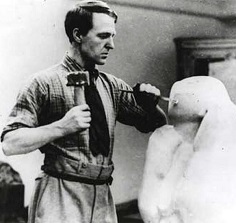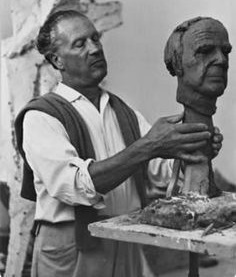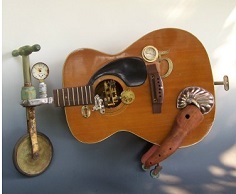
|
Home Methods Tools Workbench Emerging Links About Contact Galleries: Stone Wood Other History of sculpture    |
The Big PictureThe main methods of creating sculpture are Carving, Modelling, and Construction.There are other ways of creating 3D objects such as arranging rocks, sticks, and of course, balloons. But, to be brief, here are just the main methods as used by professional sculptors... CarvingThe sculptor chips away at a block of stone or wood with mallet and chisels to release the reclining nude trapped within it. A hasty mallet strike can break off a nose or an arm, so great care must be taken while shaping - Once it's off it's off. When the final shape is reached the sculptor then works on the surface with rasps and abrasives and polish.This is the main method used from prehistoric times, through the Classical period, the Renaissance, and then continued in 20thC. During the 18th and 19thC it became normal practice for the sculptor to model in clay or plaster, then get a craftsman to use a pointing machine to copy this into marble. Rodin was especially prolific, employing whole teams of masons to reproduce his clay models into marble. He never touched stone himself. In the early 20thC there was a rebellion by artists such as Henry Moore who objected to the pointing machine system and wanted to return to the traditional method of the sculptor carving directly into a block of stone or wood. They belived in "Truth to materials", which meant the shape and properties of stone block had a large influence on how the shape developed. Advantages - The artist is involved in every stage of the work. The stone or wood can have a beautiful and unique surface. The sculpture is a one-off. Limitations - Stone is brittle, so poses need to be quite compact with extended limbs reinforced with hidden braces - the Greeks posed their standing figures in front of tree trunks or drapery to stop them snapping off at the ankles. |



|
||
ModellingThe sculptor works in a soft medium such as clay, adding material to a rigid framework (armature) and working it with his fingers or wood and wire tools. Because clay is soft when wet the sculptor can change his mind, or refine the shape. But, when the final shape has been reached he has to hand over his work to a foundry to get a mould made, and have it cast in bronze, and recieve its "patina" - a coloured finish. The foundry can scale up, so a small clay model can become a life-size bronze.Bronzes have been made thoughout art history, but really became the main sculpture method in the 19C. Advantages - The softness of clay makes it easier to add minute detail. Cast bronze is relatively strong, so poses can be more "open" with extended limbs etc. Once a mould has been made the sculpture can be cast into large "editions". Ker-ching. Limitations - The atist has to hand over control of his work. Casting in bronze in VERY expensive so you need to have affluent buyers lined up in advance. The surface of a bronze does not have the uniqueness of stone or wood, and doesn't make you want to touch it. In fact most galleries forbid you to touch, in case grease from your fingers might ruin the patina. WARNING - If a sculpture is labelled "Cold cast bronze" it not referring to a particular method of casting bronze. It means the piece is not real bronze at all, it has been cast in resin, with some bronze powder mixed into the top layer. |


|
|||
ConstructionIn the early 20thC artists such as Picasso and Naum Gabo started experimenting with new sculpture methods and materials.Large or small scale sculpture can be made from rods and sheets of metal such as steel, copper and aluminium. For large pieces the skills required are welding, riveting and general sheet metal working. Smaller pieces can be made using tin snips, and a soldering iron or a blow torch. The most well known large metal contructions are Picasso's "Chicago" and Gormley's "Angel of the North". Constructed sculpture can also be made out of components such as plywood, cardboard, perspex, glass, fabrics and wires. These are cut and shaped then assembled by gluing or bolting the parts together. This has become very popular in recent years - it's quicker and easier than carving or modelling, and can use inexpensive or "found" materials. It has become a common form of sculpture taught in schools and colleges. Advantages - Metal constructions are ideal for outdoor display as they are not affected by weather. They don't weigh as much as stone and can be bolted together on-site, so they can easily be made to large scale. Constructions in other materials are easy and cheap, so anyone can make them without any training and without specialist tools. Limitations - Because it's a relatively recent, "no-rules" art form there are few accepted norms for what should be considered good or bad art. Consequently a lot of construction, assemblage in particular, is of questionable merit. Picasso and Gabo were already brilliant artists, so in their hands cardboard and plywood made quite brilliant sculptures. Unfortunately many people see cardboard, string and drinking straws as a fast-track option, and don't get as far as developing actual sculpting skill, or the eye that goes with it. "Assemblage" is where the artist gathers everday objects and joins them together to create often quite abstract constructions. |



|
|||